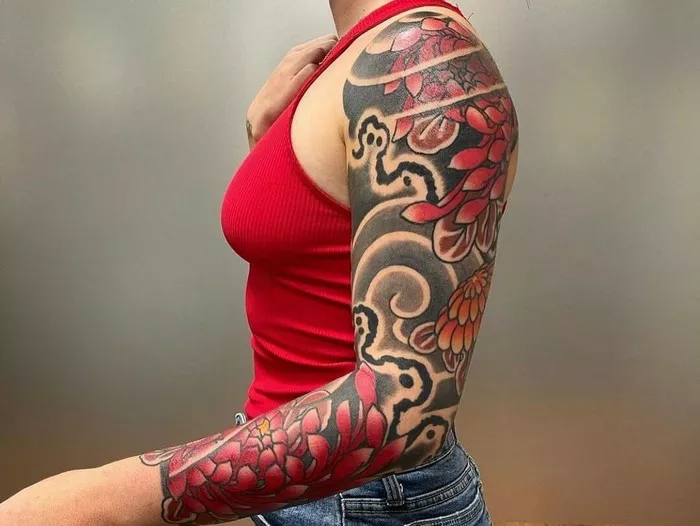Tattoos have been a part of human culture for millennia, serving as expressions of identity, beliefs, and societal roles. Among the many rich traditions of tattooing, Japanese tattoos stand out for their intricate designs, deep meanings, and historical significance. In this comprehensive exploration, we delve into the captivating world of Japanese tattoos, examining their history, meanings, symbolism, and diverse designs.
A Glimpse into History: Origins and Evolution of Japanese Tattoos
The art of tattooing in Japan dates back thousands of years, with evidence suggesting its presence as early as the Jomon period (10,000 BCE to 300 BCE). Initially practiced for spiritual and decorative purposes, tattoos gradually evolved over time, becoming deeply intertwined with Japan’s cultural and social fabric.
During the Kofun period (300 CE to 600 CE), tattoos began to signify social status and mark criminals as a form of punishment. This association with criminality persisted through the Edo period (1603-1868), a time when tattooing flourished among the lower classes, including laborers and firefighters, but remained taboo among the upper echelons of society.
It was during the Edo period that Japanese tattoos underwent a transformative shift, evolving into the elaborate and vibrant art form known as irezumi. Influenced by ukiyo-e woodblock prints and traditional Japanese mythology, irezumi artists crafted intricate designs that adorned the bodies of courtesans, samurai, and commoners alike.
Meanings and Symbolism: Decoding the Language of Japanese Tattoos
Japanese tattoos are rich in symbolism, with each motif and element carrying its own significance. From powerful mythological creatures to delicate floral patterns, every design choice reflects deeper cultural, spiritual, or personal meanings.
One of the most iconic motifs in Japanese tattooing is the dragon, symbolizing strength, wisdom, and protection. Inspired by the mythical creatures of Japanese folklore, dragon tattoos often adorn the bodies of warriors, symbolizing their bravery and resilience in the face of adversity.
Another popular motif is the koi fish, renowned for its perseverance and determination. According to legend, the koi fish swims upstream to reach the Dragon Gate, where it transforms into a dragon as a reward for its efforts. In Japanese tattooing, the koi fish represents courage, ambition, and the pursuit of one’s goals despite obstacles.
Floral motifs, such as cherry blossoms (sakura) and peonies, are also prevalent in Japanese tattoo designs, symbolizing beauty, grace, and transience. Cherry blossoms, in particular, embody the ephemeral nature of life, reminding us to appreciate the fleeting moments of beauty that surround us.
Designs and Techniques: The Artistry of Japanese Tattooing
Japanese tattooing is renowned for its meticulous attention to detail and masterful use of color and composition. Artists employ traditional techniques such as tebori (hand-poking) and irezumi (needle puncture) to create stunningly detailed designs that flow seamlessly across the body.
Tebori, in particular, is regarded as the most authentic and revered method of Japanese tattooing. Using a hand-held needle attached to a wooden or metal handle, artists painstakingly ink each stroke into the skin with precision and skill. This ancient technique allows for greater control and depth, resulting in tattoos that appear to be painted on the body rather than merely etched into the skin.
In addition to tebori, modern tattooing techniques such as machine tattooing have also gained popularity in Japan, offering artists greater efficiency and flexibility in their craft. However, many purists still prefer the traditional methods, valuing the time-honored techniques passed down through generations of tattoo masters.
The Contemporary Renaissance: Japanese Tattoos in the Modern Era
While Japanese tattoos have a long and storied history, they continue to evolve and thrive in the modern era. In recent decades, Japanese tattooing has experienced a global renaissance, with artists around the world drawing inspiration from traditional motifs and techniques.
Contemporary Japanese tattoo artists blend traditional elements with innovative styles and techniques, creating tattoos that are both timeless and cutting-edge. From neo-traditional designs to bold, graphic compositions, the world of Japanese tattooing is as diverse and dynamic as ever.
Moreover, attitudes towards tattoos in Japan are gradually shifting, with younger generations embracing tattoo culture as a form of self-expression and personal identity. While tattoos are still associated with criminality in some quarters, there is a growing appreciation for the artistry and cultural heritage of Japanese tattooing.
Conclusion
In conclusion, Japanese tattoos are more than just decorative body art; they are a reflection of Japan’s rich cultural heritage, steeped in tradition, symbolism, and artistic expression. From their ancient origins to their contemporary resurgence, Japanese tattoos continue to captivate and inspire people around the world, serving as a powerful testament to the enduring legacy of this timeless art form. Whether adorned with dragons, koi fish, or cherry blossoms, each tattoo tells a unique story, connecting the wearer to a centuries-old tradition of craftsmanship and creativity. As we look to the future, the allure of Japanese tattoos remains undiminished, a vibrant tapestry woven from the threads of history, culture, and imagination.

